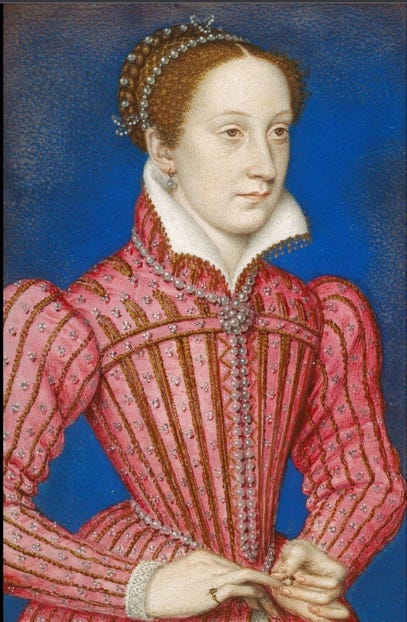Who was Mary Queen of Scots, and Why did she spend her life in captivity?
I was introduced to this intriguing figure from history by obsessing over a TV show on the CW called Reign. Taking out the drama and magic, the characters portrayed in this show mirror real people from the 16th century.

I was introduced to this intriguing figure from history by obsessing over a TV show on the CW called Reign. Taking out the drama and magic, the characters portrayed in this show mirror real people from the 16th century. From the outside, the life of Mary Queen of Scots seemed like she jumped over hurdle after hurdle to stabilize herself. As stated in previous articles, the world at the time was not kind to women in power.
Early Life
Mary Queen of Scots was born Mary Stewart on December 8, 1542, in West Lothian, Scotland. The political struggle that encircled her entire life started at an early age when her father, King James V, died when she was six days old. As his only child, this made Mary the queen of Scotland in her own right. Her mother, Mary of Guise, became regent.

Additionally, as a descendant of the Tudor family, Mary became next in line for the English throne after Queen Elizabeth I.
Instead of growing up in Scotland, Mary’s mother sent her to the French court when she was five. While there, she received an outstanding education, custom for royals at the time. Her purpose there was to be betrothed to the four-year-old son of Henry II and heir to the French throne, Frances.
Her Time in France
After living in France all this time, the pair became king and queen consort of France after King Henry II died in 1559. The court adored Mary for her charm and beauty, while they viewed Frances as stunted and weak. Frances grew up as a sickly child who was very prone to illness. Their time as rulers of France skidded to a halt in 1560 when King Frances unexpectedly died and made Mary a widow at 18.

Back to Scotland
After her husband’s death, Mary traveled back to Scotland and found that her French way of life did not sit right with the Scottish court and the public. Since she had been away for so long, the Scots did not view her as their queen. What didn’t help the situation was that Scotland changed into a Protestant nation, and Mary was a devout Catholic.
With help from her half-brother James, she instilled religious tolerance and worked to gain the people’s trust. Her biggest adversary was the Calvinist preacher, John Knox. He and his followers have been gaining popularity and steady wealth in Mary’s absence and worked tirelessly to discount Mary at every moment.
Her Second Marriage
In 1565, Mary married her cousin Henry Stewart Earl of Darnley. This match, made by passionate love, wreaked havoc on the royals of the time. Marrying another descendant of the Tudor family boosted Mary’s legitimacy for the English throne, making Elizabeth concerned and outraged. Mary’s half-brother James did not like this match either because of Darnley’s powerful family.
Darnley himself was a vicious and violent man, disliked by many who knew him. Only a year into her marriage, Darnley and his nobles murdered Mary’s secretary David Riccio in front of her eyes, and Mary couldn’t help but feel that she would be next. The couple did welcome a son named James in June of that year, but that did nothing to smooth over their prickly relationship.

In 1567, Darnley was recovering from an illness in the Kirk o’ Field house in Edinburgh. This house blew up, killing Darnley and everyone inside. The most likely culprit was the nobles who disliked Darnley, but the big mistake was Mary’s response to her husband’s death. Due to lack of counsel, Mary did not respond as a widow should and promptly married Bothwell, a chief suspect in the murder of her previous husband.
After a tumultuous love affair with Bothwell, the pair separated in 1567, with Bothwell incarcerated, where he later died, and Mary locked up on the island of Loch Leven. This move put her one-year-old son on the Scottish throne.
Her struggle in England
Mary begged her cousin Elizabeth to help her get out of imprisonment, and Elizabeth answered her plea. Little did Mary know that Elizabeth planned to keep Mary incarcerated in England to prevent her from stealing the English throne. Mary withered during her 18 years in prison.

In 1586, a plot to assassinate the English queen was revealed and brought about a Catholic uprising. The uprising convinced Elizabeth that it would no longer be wise to keep Mary alive, the sole hope for English Catholics. Mary was put on trial that same year and sentenced the execution by beheading.
Mary Stewart died in 1587 by beheading, and her body lay resting in Westminster Abbey. She sleeps in a beautiful monument created by her son James I after ascending to the Scottish throne.